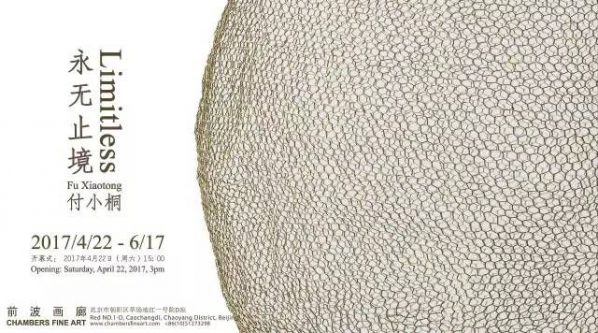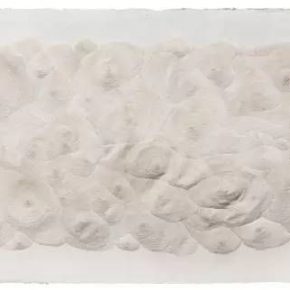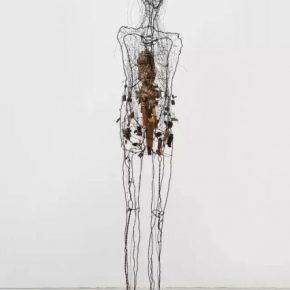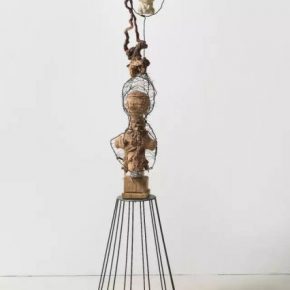
Chambers Fine Art is pleased to announce the opening on April 22, 2017 of Limitless: New Works by Fu Xiaotong. Born in Shanxi in 1976, Fu Xiaotong received her BA in Fine Arts from the Tianjin Academy of Fine Arts, Tianjin in 2000. After working at the Institute of the Arts at North China University of Science and Technology, she received her MA in Fine Arts from the department of Experimental Art, China Central Academy of Fine Arts, Beijing in 2013. This will be her second exhibition at the gallery.
Fu Xiatong has achieved wide acclaim for her remarkable works on thick sheets of hand-made Xuan paper perforated with a needle until images of subjects such as mountain ranges and powerful waves emerge from the accumulation of holes so skillfully created by her mastery of her innovative working process. In her latest paper works a more varied thematic content ranging from female breasts to cellular structures and a scull emerges from hundreds of thousands of pinpricks. Less well-known although an essential aspect of her practice is her sculpture, dramatically announced in the exhibition Land of Serenity at Chambers Fine Art in Beijing by the inclusion of Void, a life-size representation of an elephant created from metallic wire. Not quite finished – the tail and trunk were not completed – the massive form quivered at the slightest touch, an indication of her simultaneous embrace of the third dimension and rejection of its expression as sculptural mass.
In Limitless, Fu Xiaotong’s sculpture takes the foreground while a series of works on Xuan paper explores her development of a new range of imagery. Limitless consists of a group of 32 individual sculptural forms constructed from wire, metallic mesh, and a wide range of found objects including bones, ceramic ornaments, legs of tables or chairs, shoe-trees etc. Writing of this enthusiasm in 2013, she noted that “I have used a lot of antiquated readymade things and some very ordinary daily stuff in my works. I transform them and combine the readymade things with various materials such as clay, flax, leather and so on. These materials contain the ideology and spirit lost in the progress of human civilization.? My purpose is not to present a certain historical event but to integrate the ancient intellects, rites, beliefs, and other human experiences and echoes of memories in different time hierarchies into an eternal now.”
Each slightly above life-size, the assemblages are primarily vertical in format although there are exceptions such as the Mirrored Spider. There is a wide range in the degree of elaboration to which the wire framework is subjected. In some such as Dragon Egg the sculptural interest derives from the contrast between the spindly pedestal-like form constructed from metal wire and an oval form made from metallic mesh, the egg referred to in the title. Likewise Mirrored Spider is constructed from a limited range of materials and is relatively direct in its representation of an arachnid. For the most part, however, the fragile framework hosts a dizzying array of found objects, many of them apparently fetishes that have long lost their supernatural power. Examples include Moon Rabbit and the sinister Father which is constructed from iron, wood, linen, newspaper, and soil.
Assemblage, the incorporation of material and objects from the world in which we live, has been one of the primary means of sculptural expression since the early years of the twentieth century. Installations now routinely employ vast quantities of unclassifiable materials. In the selection of materials used in her assemblages Fu Xiaotong ranges at least as widely as any of her precursors but she uses them sparingly and frequently with an unexpected sense of humor. Another defining characteristic of the 32 figures that constitute Limitless is their apparent fragility. The abundant use of wire in their construction imparts a sense of instability and derives ultimately from Alexander Calder’s celebrated wire sculptures of the 1920s and early 1930s. ?Also hovering in the background is the poetic Italian sculptor Fausto Melotti whose linear sculptures are notable for their grace and lack of physical substance.
Distinguishing Fu Xiaotong from any of her spiritual forebears, however, is her belief that by incorporating fragments from the “real” world in her sculptures, she is delving deep into psychological and spiritual realities. Referring to the Current exhibition, she has noted that “Fragments of memories are like the universe, always spinning.? Like a bipolar patient, I have to use labor-intensive methods to resist fear.? ?Puncturing thousands of holes on smooth paper, it piles up like wrinkled skin. Using recycled copper wire to braid a hexagonal snake motif, and rusty iron wire to tie together different kinds of waste material - from ruined architecture to broken steel bars, all are evidence of the circle of destruction and re-creation in human society. ?This series of works becomes a comprehensive revelation of the nature of physical reality and ideologies that exist beyond time and place. It is a metaphor for “nature or the “l(fā)ife-cycle.”
About the exhibition
Dates: April 22 – June 17, 2017
Venue: Chambers Fine Art, Beijing
Courtesy of the artist and Chambers Fine Art, for further information please visit www.chambersfineart.com.





































